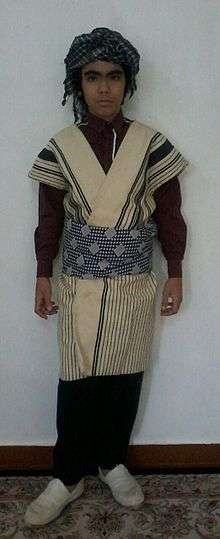Feyli Lurs
Feyli Lurs[1][2][3] (Feyli Lurish: لوره یل فه یلی) are a part of Lur people mainly live in Luristan, Kermanshah and Ilam province.[4] The Safavid era historian, Mirza Muhammad Husein Mostowfi (1749 A.D), classified Feyli alongside Laki, Bakhtiari and Mamasani as four subgroup of Lurish people.[5] Lurish is related to Indo Iranian language. Feyli lurs in Iraq live mainly in Wasit, Diyala and Meysan.
Ethnogenesis
Feyli Lurs are a community living in Baghdad and the Diyala Province of Iraq around Mandali, and across the Iranian border, mainly in the provinces of Luristan and south of Ilam. The Fayli are an important community within the wider luri people. Faylee (Faylee, Faili, or Feli) are, according to our opinion part of the Lurish population in Iraq and an integral part of the Lurish nation, though others believe they are much more related to Persians. Faylee have themselves shown, over the years, and still show this fact and reality by words and deeds. They speak Feyli, a dialect that belongs to the Lurish language. Feyli is spoken particularly on both sides of the border areas between Iraq and Iran.[6] In addition to their Feyli Lurish dialect, a special Lurish clothing distinguishes Feyli Lurs from other Lurish subgroups.[7]

Historic roots of the Feylis
The roots of the Feyli go back to the Parthian/Pahlawi/Pahlawanid settlements of the 2nd century BC. Archaeological evidence from the Ilam Province in Iran indicates that some proportions of Fayli might have been Nestorian Christians until the 18th century. The conversion to Shia form of Islam seem to have begun under the Safavid dynasty (1507–1721) of Persia/Iran, Faylis today are primarily Imami Shias like the Persians, kurds and the Azeris, as well as the majority of the Iraqi Arabs.
Contemporary history of Feylis
In modern times the Feylis have been subject to state persecution.[8][9] They are considered as a stateless people, with both Iran and Iraq claiming they are citizens of the other country.[10] In the mid 1970s, Iraq expelled around 40,000 Feyli's who had lived for generations near Baghdad and Khanaqin, alleging that they were Iranian nationals.[11]
References
- ↑ Contributions to the anthropology of Iran,Henry Field
- ↑ http://www.anthrogenica.com/archive/index.php/t-5207.html
- ↑ Nomadism in Iran From Antiquity to the Modern EraD. T. Potts
- ↑ C. A. de Bode, Travels in Luristan and Arabistan II, London, 1845, p. 290
- ↑ (فرهنگ ایران زمین، جلد 20، ص 406-409)
- ↑ H. Field, Contributions to the Anthropology of Iran, Chicago, 1939.
- ↑ Clothes of Feyli Lurs in Luristan and Ilamlast=QaedRahmat (illustrated, revised reprint ed.), Motie Press, Qom, 2014
- ↑ A. H. Layard, “Description of the Province of Khuzistan,” JRGS 16, 1846, pp. 99-100.
- ↑ O. Mann, Die Mundarten der Lur-Stämme im südwestlichen Persien, Berlin, 1910, pp. xxiv-xxv.
- ↑ V. Minorsky, “Lur,” EI2 V, pp. 820-26.
- ↑ P. Oberling, The Turkic Peoples of Southern Iran, New York, 1960.
